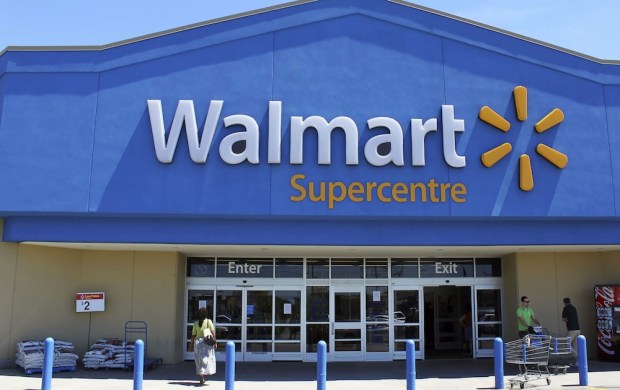Walmart Hits With Grocery, Misses Big Online

After three consecutive quarters of eCommerce growth that was north of 50 percent, Walmart’s digital sales grew less than half of that last quarter – and investors were less than thrilled.
That was on top of news that Walmart’s increased profit-margin pressure was pushing an annual revenue estimate for 2018 that missed investor expectations.
Despite the concern – and a corresponding 9 percent drop in Walmart’s stock price that shaved some $29 billion from its market cap – CEO Doug McMillon told analysts he remains confident that 2018 digital sales performance will be in parity to its 2017 performance.
“Looking ahead, we expect eCommerce growth to increase from the fourth-quarter level as we enter the new year,” McMillon noted.
According to Walmart’s official figures, eCommerce averaged 44 percent for 2017. That growth was buoyed by Walmart’s aggressive pursuit of digital sales as it has sought to compete more directly and successfully with Amazon’s stronghold on eCommerce in the U.S.
Walmart acquired Jet.com for roughly $3 billion in September 2016, followed by a series of eCommerce investments throughout 2017, including Bonobos, ModCloth and Moosejaw. Walmart also expanded its buy online/pick up in store capacity, grew its digital payments platform (Walmart Pay) and generally re-centered its focus on integrating its massive physical scale with its upgraded eCommerce efforts.
Those efforts had shown signs of strength and success, marked by Walmart’s explosive digital growth throughout most of 2017 – which is why, according to Simeon Gutman, retail analyst for Morgan Stanley, the market was so singularly disappointed in the latest round of results.
“This quarter did not live up to those high expectations,” he noted, despite strong sales that came in above analyst expectations.
By the Numbers
Walmart reported earnings of $1.33 a share in Q4, short of analysts’ expectations of $1.37. That mild miss, Walmart noted, came as the firm pulled forward some investments for tax purposes.
Same-store sales, physical retail’s most-watched metric, grew 2.6 percent during the quarter, beating out forecasts of a 2 percent growth. Food, apparel and toys made a particularly strong showing in Q4.
eCommerce sales were also up 23 percent during the quarter, though down quite significantly from prior quarters. McMillon assured investors that 2018 should see an average eCommerce sales growth rate of 40 percent.
That growth prediction, however, came in the context of Walmart cutting its net sales growth forecast by as much as half, to a range of 1.5 percent to 2 percent. Those dips, according to CFO Brett Biggs, are owed to the decision to stop tobacco sales in some Sam’s Club warehouse locations and to eliminate a large part of its Brazilian eCommerce business.
The company also closed 63 Sam’s Club units last month.
Walmart said Tuesday that earnings per share would come in between $4.75 and $5.00 for the current fiscal year, below investors’ expectations, as there had been some thought that profits would be lifted a bit by the tax code changes.
As for those tax changes, Walmart is logging a provisional benefit of $207 million for the fourth quarter and full year. It sees an effective tax rate of between 24 and 26 percent, which is “a little higher than some expected,” Biggs noted.
The company said it expects a cash benefit of about $2 billion for the year as a result of the tax overhaul.
Beyond the Numbers
Though Walmart is forecasting strong eCommerce growth, it did acknowledge that Q4’s digital performance was not up to snuff.
“We were a bit lower than plan” in eCommerce, Biggs noted in a post-earnings interview with Bloomberg. “We had a few operational issues from an inventory replenishment perspective.”
Although Biggs did not elaborate, McMillon noted in his conversation with analysts that some of the issue stemmed from holiday goods like TVs and toys flooding Walmart’s eCommerce warehouses and squeezing out room for everyday items. “Our in-stock for basic items suffered as a result,” McMillon noted.
This issue, among others, is on Walmart’s priority list for 2018. McMillon used yesterday’s post-earnings rap session to outline Walmart’s evolving strategy when it comes to pursuing eCommerce, with a greater focus on drawing consumers to its core Walmart.com brand while slowing its marketing for Jet. Historically, Jet caters to higher-income urban shoppers, and Walmart is predicting that Jet sales may take a hit.
“The cost to acquire a new customer on a nationwide basis is cheaper with the Walmart brand, so we’ve been investing more in Walmart.com on a national basis and reducing marketing investment in Jet, except in certain urban markets,” McMillon noted, while affirming that Walmart intends to build out from Jet’s strength with “higher-income, urban, millennial customers.”
Going forward, said McMillon, Walmart will continue to evaluate themselves on the total U.S. eCommerce growth number.
McMillon also noted that the switch to more online sales is taking something of a toll on profit margins, as digital sales are generally less profitable than in stores.
But he also called out some of Walmart’s digital successes, and plans to build on them – such as its online grocery platform, which is counted as online sales.
McMillon noted that the development of that segment is in line with what the brand is hoping to develop across its multi-channel retail platform – and that 2018 will see Walmart doubling down on it in the U.S. and around the world.
“We’ll lean in this year by nearly doubling the number of online grocery locations in the U.S.,” McMillon predicted.
In response to an analyst question, McMillon also noted that Walmart will continue to explore grocery delivery as a possible expansion – but not with quite the same full-court press that order online/pick-up curbside is receiving.
“As it relates to grocery delivery, we’ve had this small pilot going on with our own associates, and we’ll continue to play around with that and learn what works there. But the expansion will happen through a variety of platforms. Depending on the spot in the country, we’ll use different providers to get the product to the customer,” he noted.
Walmart’s stock fell nonetheless – the 9 percent plunge represented the retailer’s worst day on Wall Street in about two years. But investors, though concerned – particularly as the Amazon challenge is getting more pointed – are still, provisionally at least, on board with Walmart’s efforts, provided they bear better fruit going forward in 2018.
